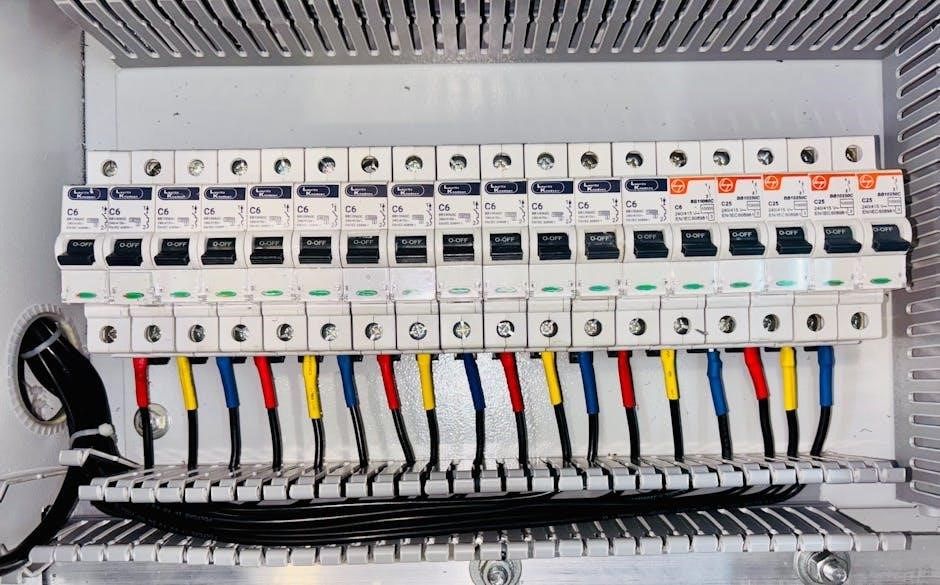Toyota wiring diagrams are detailed schematics that map out a vehicle’s electrical system, using standardized color codes to represent different wires and their functions. These diagrams are essential for understanding and repairing electrical systems, helping technicians identify components, connections, and troubleshoot issues efficiently. By following these diagrams, one can accurately diagnose and repair electrical faults, ensuring system reliability and performance. They are indispensable for both professional mechanics and DIY enthusiasts working on Toyota vehicles.

Understanding Toyota Wiring Diagram Color Codes
Toyota wiring diagrams use standardized color codes to simplify complex electrical systems, ensuring quick identification of wires by their functions. These codes are critical for accurate diagnostics and repairs.
2.1 Standard Colors Used in Toyota Wiring Diagrams
In Toyota wiring diagrams, standard colors are used to represent different wire functions, ensuring clarity and consistency. Black typically indicates ground wires, while red often signifies power or battery connections. White wires usually represent switched power, and yellow may denote illumination or accessory circuits. Green, blue, and brown are commonly used for various control signals and sensors. Purple and orange are reserved for specialized functions, such as entertainment systems or advanced driver-assistance features. These standardized colors simplify the identification of electrical pathways, enabling technicians and enthusiasts to diagnose and repair issues efficiently. This uniform approach ensures reliability and reduces the risk of errors during electrical system maintenance or modifications.
2.2 Special Cases and Exceptions in Color Coding
While Toyota wiring diagrams primarily use standardized colors, there are exceptions and special cases that vary by model or system. For instance, certain advanced features like hybrid systems or infotainment modules may use unique color schemes to differentiate their circuits. Additionally, optional equipment or aftermarket upgrades can introduce non-standard colors, requiring specific documentation for accurate interpretation. Some models may also use dual-color coding for complex functions, combining two colors to denote a single wire’s purpose. These variations highlight the importance of consulting model-specific diagrams and supplements to ensure accurate repairs and modifications. Understanding these exceptions is crucial for avoiding misinterpretations and ensuring electrical system reliability.

How to Read a Toyota Wiring Diagram
Reading a Toyota wiring diagram involves identifying symbols, color codes, and components to understand electrical circuits. It helps diagnose issues, plan modifications, and ensures safe, accurate repairs.
3.1 Key Components of a Wiring Diagram
A Toyota wiring diagram consists of several essential components that help technicians understand the electrical system. These include wire color codes, which identify specific circuits, and _symbols representing components like switches, relays, and fuses. Connectors and terminals are also labeled, showing where wires connect to parts like sensors or actuators. The diagram may feature a legend explaining symbols and colors, ensuring clarity. Additionally, circuits are grouped logically, making it easier to trace power and ground paths. Understanding these components is crucial for diagnosing faults, planning repairs, and ensuring modifications are done safely and correctly. These elements work together to provide a comprehensive guide to the vehicle’s electrical layout.
3.2 Step-by-Step Guide to Interpreting the Diagram
Start by locating the legend or key on the wiring diagram, which explains the meaning of symbols and color codes. Identify the specific circuit you want to work on by cross-referencing the diagram with your vehicle’s electrical system. Trace wires carefully, following their paths from one component to another. Use the color codes to identify positive, ground, and signal wires. Check for connectors, relays, and fuses along the circuit. If a wire is damaged or disconnected, the diagram will help pinpoint its location. For complex systems, break the diagram into sections and focus on one area at a time. Always refer back to the color code chart to ensure accuracy. Finally, use a multimeter to verify voltage and continuity before making repairs.

Common Symbols and Abbreviations in Toyota Wiring Diagrams
Toyota wiring diagrams use standardized symbols and abbreviations to represent electrical components and connections. Common symbols include circles for connectors and squares for switches. Abbreviations like GND (ground) and BATT (battery) are frequently used. Understanding these symbols is crucial for accurately interpreting the diagram. Some symbols are universal, while others are specific to Toyota models, ensuring precise identification of wires and components for effective repairs and troubleshooting.
4.1 Standard Symbols Used Across Toyota Models
Toyota wiring diagrams utilize a set of standard symbols to represent electrical components consistently across all models. Common symbols include circles for connectors, squares for switches, and triangles for fuses. These symbols are universally recognized, simplifying the interpretation of complex systems. For example, a battery is often depicted with two parallel lines, while a ground connection is shown as a downward-pointing arrow. Relays, resistors, and capacitors also have distinct representations. These standardized symbols ensure clarity and consistency, allowing technicians to quickly identify components and their functions. This uniformity is crucial for efficient repairs and troubleshooting, making Toyota wiring diagrams accessible to both professionals and DIY enthusiasts. Understanding these symbols is the first step in mastering the diagram’s language.
4.2 Manufacturer-Specific Symbols and Abbreviations
Toyota incorporates unique symbols and abbreviations tailored to their specific electrical systems. These manufacturer-specific elements may differ from those used by other automakers, ensuring precise communication within Toyota’s engineering context. For instance, abbreviations like “ECU” for Engine Control Unit or “CAN” for Controller Area Network are frequently used. Symbols such as a zigzag line for noise filters or a coiled line for ignition coils are Toyota-specific. These specialized symbols enhance the clarity of Toyota’s wiring diagrams, reflecting their advanced technological features. Familiarity with these proprietary symbols is essential for accurately interpreting Toyota diagrams, as they often represent functions unique to their vehicles. This specificity ensures that technicians can pinpoint components and systems efficiently, optimizing repair processes.

Tools and Software for Viewing and Editing Wiring Diagrams
Essential tools include PDF viewers like Adobe Acrobat for viewing diagrams and AutoCAD or specialized software for editing. These tools enable accurate interpretation and modifications of Toyota wiring diagrams.
5.1 Recommended Software for PDF Viewing
Adobe Acrobat Reader is the most popular choice for viewing PDF files, including Toyota wiring diagrams. It offers features like zoom, search, and bookmarks for easy navigation. Foxit Reader is another lightweight alternative with similar functionality. Nitro PDF Reader provides advanced tools like annotation and form filling. SumatraPDF is a fast and minimalist option for basic viewing needs. These tools ensure that users can access and interpret wiring diagrams clearly. For mobile users, Adobe Acrobat Reader and Foxit PDF Reader offer reliable apps. Ensuring the correct software is essential for accurately reading and understanding Toyota wiring diagrams.
5.2 Essential Tools for DIY Electrical Projects
For DIY electrical projects involving Toyota wiring diagrams, essential tools include a multimeter for voltage and resistance testing, wire strippers for safely removing insulation, and a heat gun for shrinking heat shrink tubing. Pliers and screwdrivers are crucial for manipulating wires and connectors. A soldering iron ensures secure connections, while a wiring diagram provides guidance. Safety gear like gloves and goggles protects against electrical hazards. Additionally, a parts organizer keeps components tidy. These tools are indispensable for accurate and efficient electrical repairs and modifications, helping to maintain system reliability and performance.

The Role of Color Codes in Troubleshooting Electrical Issues
Color codes in Toyota wiring diagrams are crucial for identifying wires by function, enabling quick diagnosis of electrical faults. This reduces confusion and speeds up repairs.
6.1 Identifying Faults Using Color Codes
Toyota wiring diagrams use color codes to simplify fault identification. By cross-referencing wire colors with the diagram, technicians can pinpoint faulty circuits or connections. For instance, a red wire typically indicates a power source, while a black wire often signifies ground. If a component isn’t functioning, checking the corresponding colored wires can reveal breaks, shorts, or misconnections. This method streamlines troubleshooting, reducing diagnostic time. Additionally, color codes help trace wires through complex systems, ensuring repairs are accurate and efficient. Proper use of these codes minimizes errors, preventing further damage to the electrical system. This systematic approach is vital for maintaining Toyota vehicles’ reliability and performance.
6.2 Real-World Examples of Successful Troubleshooting
A common issue in Toyota vehicles is intermittent dashboard warning lights. Using wiring diagrams, technicians identified a faulty ground wire, colored black, causing the malfunction. Another example involved a Toyota Camry with a non-functional rear defroster. By referencing the wiring diagram, the technician traced the issue to a disconnected purple wire in the defroster circuit. In a Toyota 4Runner, a blown fuse in the ABS system was diagnosed by following the yellow and green wires, which led to a short circuit. These real-world cases demonstrate how color codes in wiring diagrams enable precise and efficient troubleshooting, ensuring repairs are both accurate and timely. Such examples highlight the practical value of understanding Toyota’s color coding system for effective electrical diagnostics and maintenance.
Safety Tips When Working with Toyota Wiring Systems
Always disconnect the battery before starting work to avoid electrical shocks. Wear protective gear, including gloves and safety glasses. Use insulated tools to prevent accidental short circuits. Ensure proper grounding and avoid working near open flames or sparks. Regularly inspect wiring for damage and ensure all connections are secure. Follow Toyota’s recommended safety protocols to minimize risks and ensure a safe working environment while handling electrical systems.
7.1 Best Practices for Safe Electrical Work
When working with Toyota wiring systems, always begin by disconnecting the battery to eliminate the risk of electrical shock or accidental ignition. Use insulated tools to handle live wires and avoid wearing jewelry that could conduct electricity. Ensure good lighting in your workspace to clearly see components and connections. Never work near open flames or sparks, as this can ignite flammable gases or vapors. Reference the Toyota wiring diagram color codes to identify live wires accurately. Ground yourself properly to prevent static discharge, which can damage sensitive electronics. Keep a fire extinguisher nearby and ensure all power sources are turned off before starting repairs. Regularly inspect tools and wiring for damage to maintain a safe working environment. Always follow Toyota’s recommended safety guidelines to protect yourself and ensure reliable electrical system performance. By adhering to these best practices, you can minimize risks and achieve successful outcomes in your electrical work.
7.2 Essential Protective Gear and Equipment
When working with Toyota wiring systems, wearing proper protective gear is crucial to ensure safety. Essential items include safety glasses to protect eyes from debris or sparks and insulated gloves to prevent electrical shock. A grounding strap is necessary to prevent static electricity damage to sensitive components. Use insulated tools, such as pliers and screwdrivers, to handle live wires safely. A multimeter is also vital for testing voltage and current without risking personal harm. Steel-toe boots and a fire-resistant apron provide additional protection in case of accidents. Always keep a fire extinguisher nearby to address potential electrical fires. Proper protective gear minimizes risks and ensures a safe working environment when diagnosing or repairing Toyota electrical systems.

Importance of Accurate Color Codes in Toyota Wiring Diagrams
Accurate color codes are crucial for correctly identifying and connecting wires, ensuring proper electrical system functionality. They prevent errors, enhance safety, and maintain vehicle performance and reliability.
8.1 Reducing Errors in Electrical Repairs
Accurate color codes in Toyota wiring diagrams play a critical role in minimizing errors during electrical repairs. Misinterpreting wire colors can lead to incorrect connections, causing malfunctions or even safety hazards. By adhering to standardized color codes, technicians can identify circuits and components quickly, ensuring repairs are done correctly. For instance, a red wire typically signifies a power source, while a black wire often represents ground. This consistency reduces confusion and prevents costly mistakes. Proper use of color codes also streamlines troubleshooting, as technicians can trace issues more efficiently. Ultimately, accurate color codes enhance precision, safety, and reliability in electrical repairs, making them indispensable for both professionals and DIY enthusiasts.
8.2 Ensuring System Reliability and Performance
Accurate Toyota wiring diagram color codes are vital for maintaining system reliability and performance. Each color represents specific functions, ensuring connections are precise and reliable. Properly following these codes prevents cross-wiring, which can lead to system failures or safety risks. For example, a yellow wire might indicate a sensor input, while a green wire could signify a control signal. By adhering to these standards, technicians ensure all components interact as intended, preserving the vehicle’s electrical integrity. This attention to detail minimizes the risk of malfunctions, ensuring optimal performance and longevity of the electrical system. Reliable connections translate to consistent operation, making accurate color codes essential for maintaining Toyota vehicles at peak functionality.

Finding Reliable Toyota Wiring Diagrams and Resources
Official Toyota sources, such as the Toyota website, service manuals, and authorized dealerships, provide the most reliable wiring diagrams. Third-party forums and websites may also offer helpful resources, but ensure their credibility before use.
9.1 Official Toyota Sources for Wiring Diagrams
Toyota’s official website offers comprehensive wiring diagrams and repair manuals for various models, providing detailed color codes and electrical system schematics. Additionally, Toyota dealerships and certified service centers maintain extensive libraries of wiring diagrams tailored to specific vehicle models. These resources are updated regularly to reflect the latest technical specifications and are accessible through subscription-based platforms or direct purchase. For accurate and reliable information, enthusiasts and professionals rely on these official sources, ensuring adherence to manufacturer standards and reducing errors in repairs and modifications. Using official Toyota resources guarantees authenticity and clarity, essential for complex electrical projects and troubleshooting.
9.2 Third-Party Websites and Forums
Beyond official sources, third-party websites and forums provide accessible wiring diagrams and color codes for Toyota vehicles. Platforms like ToyotaNation, Reddit communities, and specialized automotive forums often host user-shared diagrams and repair guides. Websites such as Autozone or O’Reilly Auto Parts may also offer free access to wiring diagrams. While these resources can be valuable, they require verification for accuracy and relevance to specific models. Forums are particularly useful for troubleshooting and gaining insights from experienced enthusiasts and mechanics. However, reliance on third-party sources should be cautious, as information accuracy may vary. Always cross-reference with official materials to ensure reliability and safety during repairs and modifications.

Common Mistakes to Avoid When Using Wiring Diagrams
Common mistakes include misinterpreting color codes, overlooking model-specific variations, and not cross-referencing diagrams with official Toyota resources, which can lead to incorrect repairs and safety hazards.
10.1 Misinterpreting Color Codes and Symbols
Misinterpreting Toyota wiring diagram color codes and symbols is a common mistake that can lead to incorrect repairs. Ensuring accuracy is crucial, as each color represents specific functions. For instance, black wires often denote ground connections, while yellow wires may indicate voltage supply lines. Symbols, such as circles for connectors or triangles for fuses, must be identified correctly to avoid confusion. Additionally, special cases like dashed lines for splice points or dotted lines for multi-wire connectors can be easily overlooked. Always cross-reference with official Toyota manuals or resources to confirm interpretations. Misreading these elements can result in faulty repairs, electrical failures, or even safety hazards. Attention to detail and proper training are essential to avoid such errors. Using reliable tools and guides further minimizes the risk of misinterpretation, ensuring accurate and safe electrical work.
10.2 Overlooking Critical Details in the Diagram
Overlooking critical details in Toyota wiring diagrams can lead to costly repairs or safety hazards. Key elements like connector labels, wire thickness, and ground points are often missed. Neglecting these can result in incorrect connections or undiagnosed faults. For example, ignoring splice points or multi-wire connectors can cause system malfunctions. Additionally, failing to notice notes or warnings in the diagram may lead to improper repairs. Always thoroughly examine the entire diagram, paying attention to small symbols and annotations. Using tools like magnifiers or zoom features can help spot overlooked details. Double-checking against official Toyota manuals ensures accuracy. Skipping these steps risks electrical failures, fire hazards, or chronic issues. Attention to detail is paramount for reliable and safe electrical system maintenance.

Differences in Wiring Diagrams Across Toyota Models
Toyota wiring diagrams vary by model, reflecting differences in electrical systems, components, and features. While color codes remain consistent, diagram complexity and specific connections differ across models like Camry, Corolla, and others, requiring model-specific diagrams for accuracy.
11.1 Variations in Diagrams for Different Vehicle Models
Toyota wiring diagrams differ significantly across various vehicle models due to variations in electrical systems, features, and technologies. For instance, diagrams for a Toyota Camry will vary from those for a RAV4 or 4Runner, as each model has unique components like infotainment systems, drivetrain configurations, and safety features. Even within the same model, differences in trim levels, optional packages, or model years can lead to distinct wiring layouts. Additionally, hybrid models often have separate diagrams for their electric motor and battery systems. These variations emphasize the importance of using model-specific diagrams to ensure accuracy and avoid potential errors during repairs or modifications. Always consult the correct diagram for your vehicle to guarantee proper electrical system functionality.






























